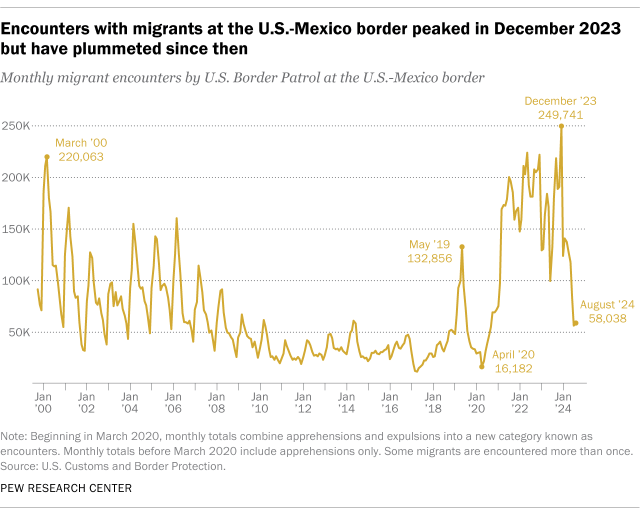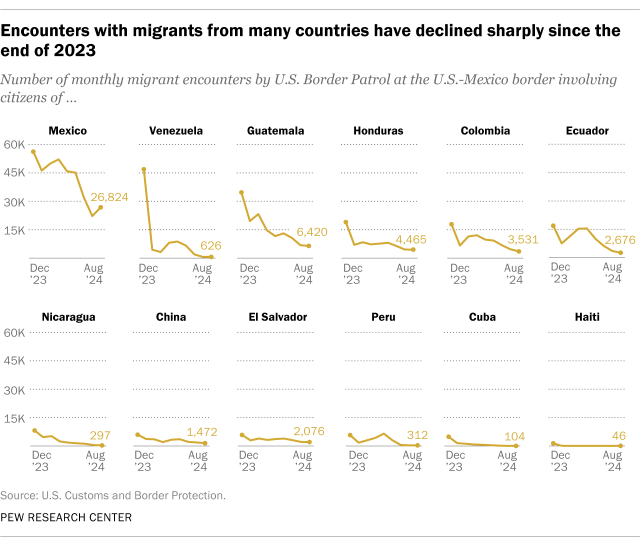After reaching a record high at the end of 2023, the monthly number of U.S. Border Patrol encounters with migrants crossing into the United States from Mexico has plummeted so far in 2024.

The Border Patrol recorded 58,038 encounters with migrants crossing the U.S.-Mexico border in August, according to a Pew Research Center analysis of the latest available government statistics. That was a 77% decline from 249,741 encounters in December 2023, the most ever recorded in a single month.
This Pew Research Center analysis examines migration patterns at the U.S.-Mexico border using current and historical data from U.S. Customs and Border Protection, the federal agency that includes the U.S. Border Patrol. The analysis is based on a metric known as migrant encounters.
The term “encounters” can refer to different types of events. In this analysis, it refers to Border Patrol apprehensions of migrants who cross into the United States without authorization. These migrants are taken into custody, at least temporarily, to await a decision on whether they can remain in the U.S. legally, such as by being granted asylum. Migrants who are not granted asylum are typically deported.
It is important to note that encounters refer to events, not people, and that some migrants are encountered more than once. As a result, the overall number of encounters is higher than the number of distinct individuals involved.
This analysis is limited to monthly encounters between ports of entry involving the Border Patrol. It excludes encounters at ports of entry involving the Office of Field Operations, a federal law enforcement agency within Customs and Border Protection.
Public opinion data in this analysis comes from Center surveys conducted in January 2024 and August 2024. Methodological information about these surveys, including their field dates and sample sizes, is available by following the links in the text.
The decline in encounters has come amid policy changes on both sides of the border. Authorities in Mexico have stepped up enforcement to prevent migrants from reaching the U.S. border. And U.S. President Joe Biden issued an executive order in June that makes it much more difficult for migrants who enter the U.S. without legal permission to seek asylum and remain in the country.
The term “encounters” can refer to different types of events. In this analysis, it refers to Border Patrol apprehensions of migrants who cross into the U.S. without authorization. These migrants are taken into custody, at least temporarily, to await a decision on whether they can remain in the U.S. legally, such as by being granted asylum. Migrants who are not granted asylum are typically deported.
Changing migration patterns at the border
The dramatic increase in migrant encounters at the U.S.-Mexico border at the end of 2023 drew widespread criticism from the American public about the government’s handling of the situation, according to a Center survey conducted in early 2024. At the time, 78% of U.S. adults said the large number of migrants seeking to enter the U.S. at the border with Mexico was either a crisis or a major problem. A similar share (80%) said the U.S. government was doing a bad job dealing with the situation.
Since the end of 2023, however, the monthly number of encounters has declined sharply, including large decreases in encounters with citizens of Mexico and the Northern Triangle countries of El Salvador, Guatemala and Honduras. These nations have been among the most common origin countries for migrants encountered at the U.S.-Mexico border in recent years.
- The monthly number of encounters with citizens of Guatemala decreased 81% between December 2023 and August 2024, from 34,693 to 6,420.
- Encounters with citizens of Honduras fell 76%, from 18,993 to 4,465.
- Encounters with citizens of El Salvador fell 64%, from 5,818 to 2,076.
- Encounters with citizens of Mexico fell 52%, from 56,240 to 26,824.

There have also been sharp decreases in encounters with citizens of other countries, including some that historically have not been common origin nations for migrants crossing the U.S.-Mexico border.
- Encounters with citizens of Venezuela plunged 99% between December 2023 and August 2024, from 46,918 to 626.
- Encounters with citizens of Cuba fell 98%, from 4,964 to 104.
- Encounters with citizens of Haiti fell 97%, from 1,392 to 46.
- Encounters with citizens of Nicaragua fell 96%, from 8,176 to 297.
- Encounters with citizens of Peru fell 95%, from 5,742 to 312.
- Encounters with citizens of Ecuador fell 84%, from 16,951 to 2,676.
- Encounters with citizens of Colombia fell 80%, from 17,874 to 3,531.
- Encounters with citizens of China fell 75%, from 5,951 to 1,472.
In August, 69% of encounters involved migrants from Mexico or the Northern Triangle region. That was a shift from December 2023, when only 46% did.
The majority of encounters continue to involve single adults. In August, 62% of all encounters involved single adults, while 27% involved people traveling in families and 11% involved unaccompanied minors. In December 2023, a slightly smaller share of encounters (54%) involved single adults, while 41% involved people traveling in families and 5% involved unaccompanied minors.
Immigration remains key election issue
Despite the large decrease in migrant encounters this year, border security remains a key issue in the 2024 U.S. presidential election, according to a Center survey fielded in August.
In fact, 88% of registered voters strongly or somewhat favor improving security along the country’s borders. That includes 96% of voters who support former President Donald Trump and 80% of voters who support Vice President Kamala Harris.
Note: This is an update of a post originally published on March 15, 2021.
